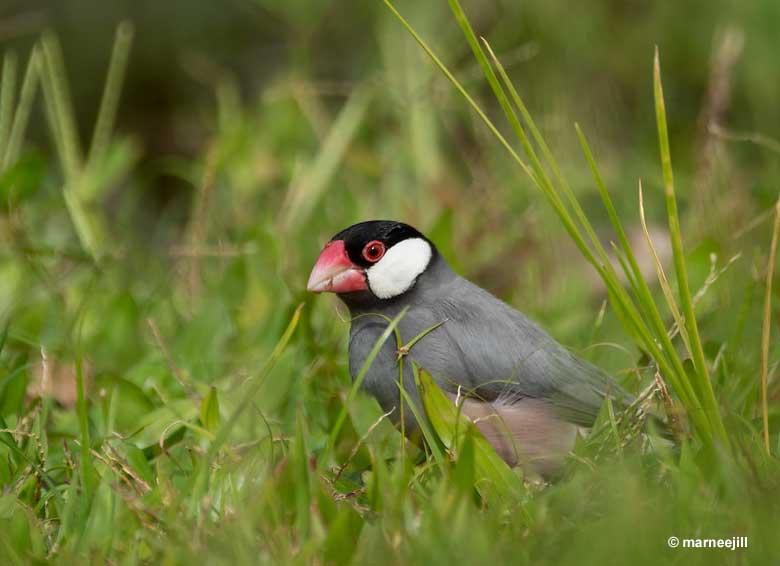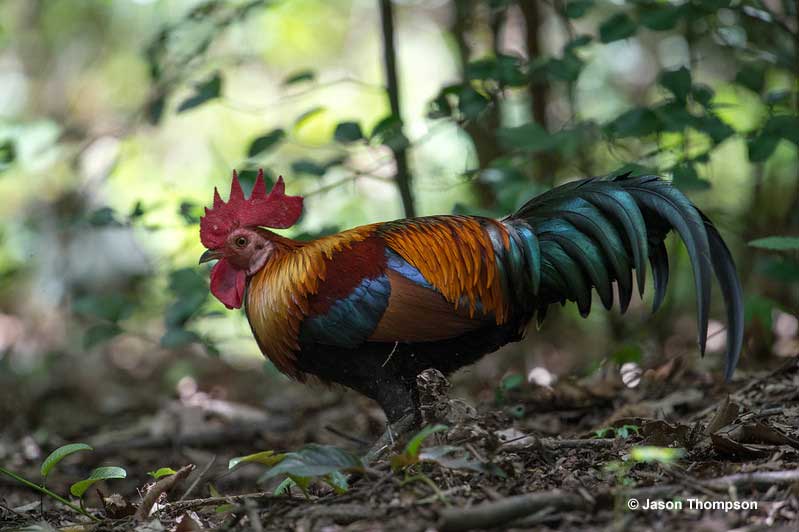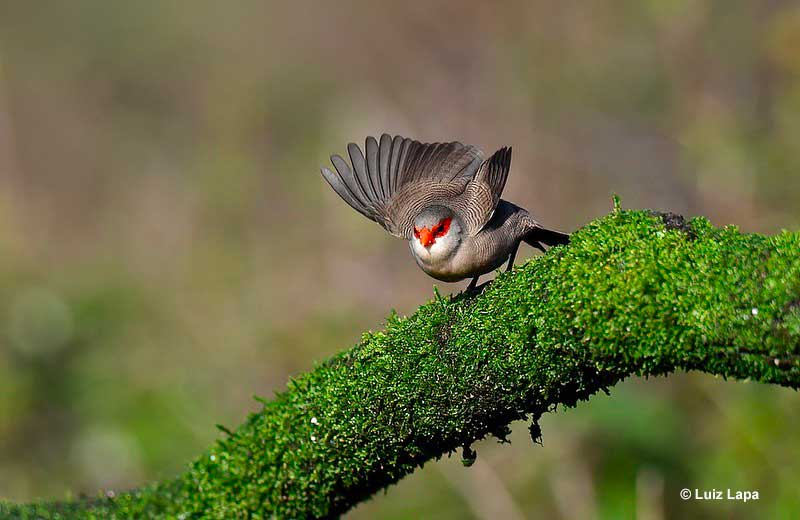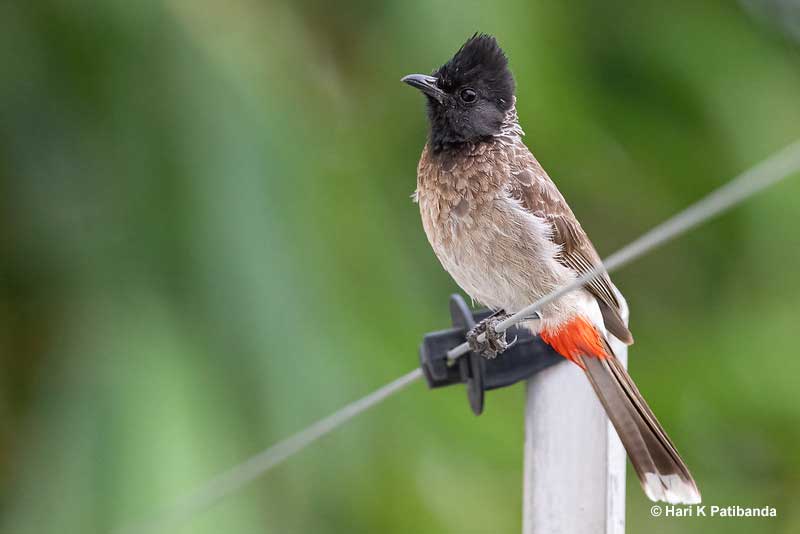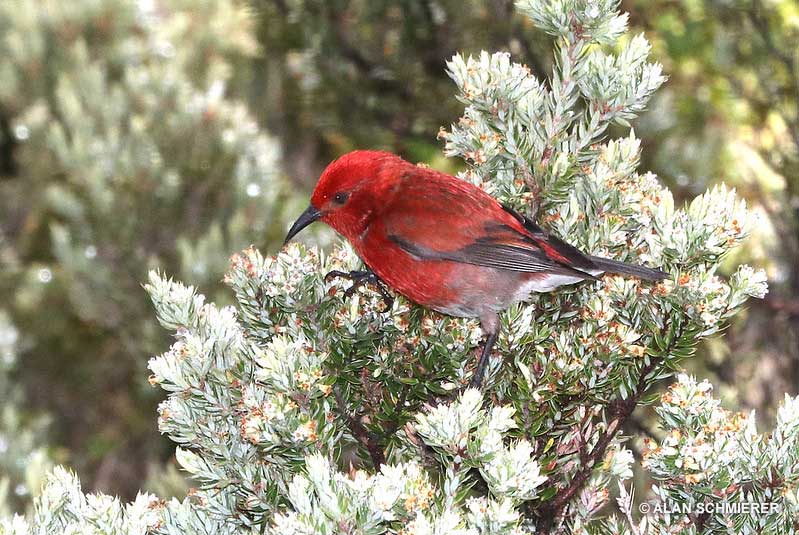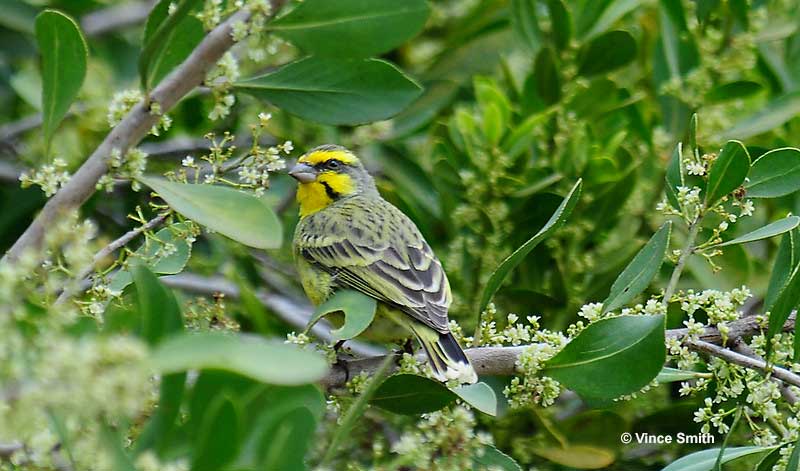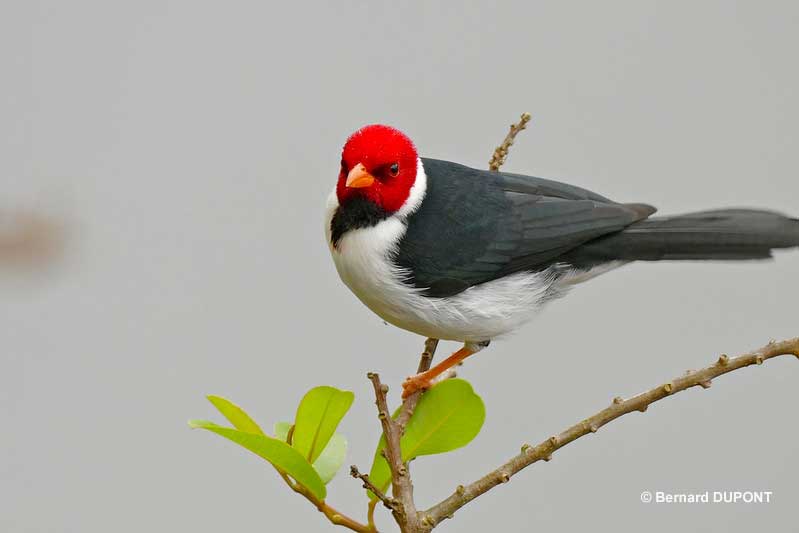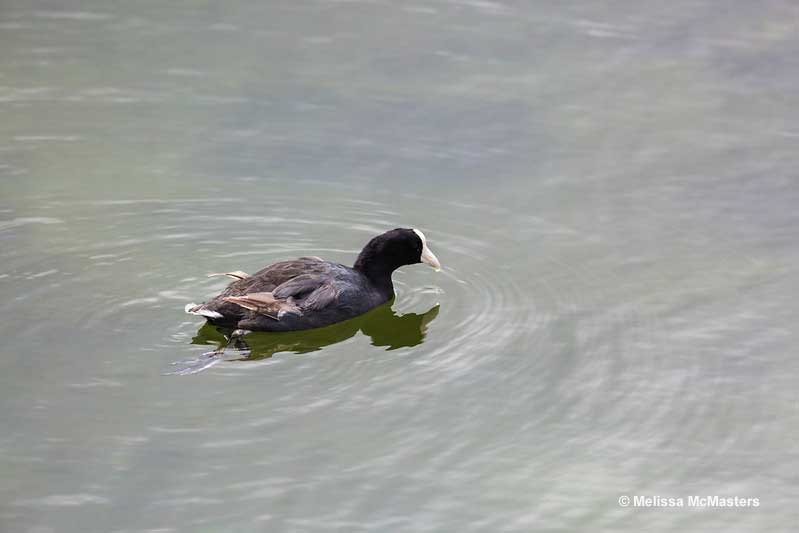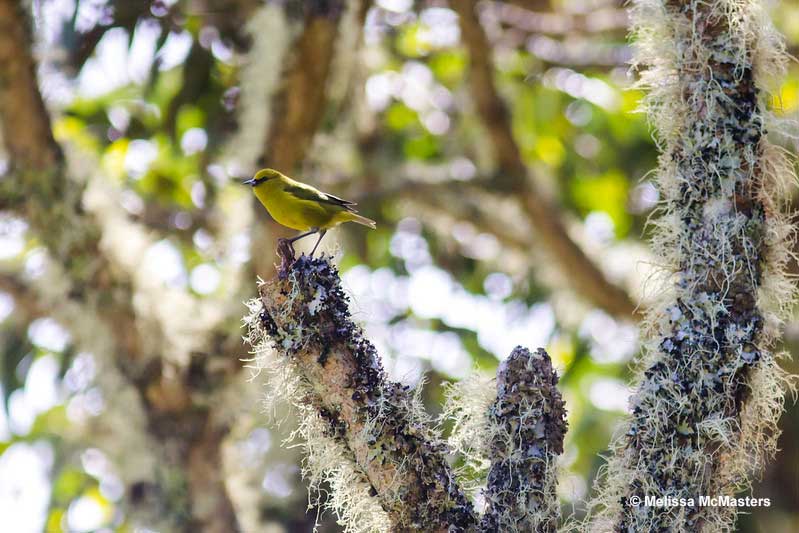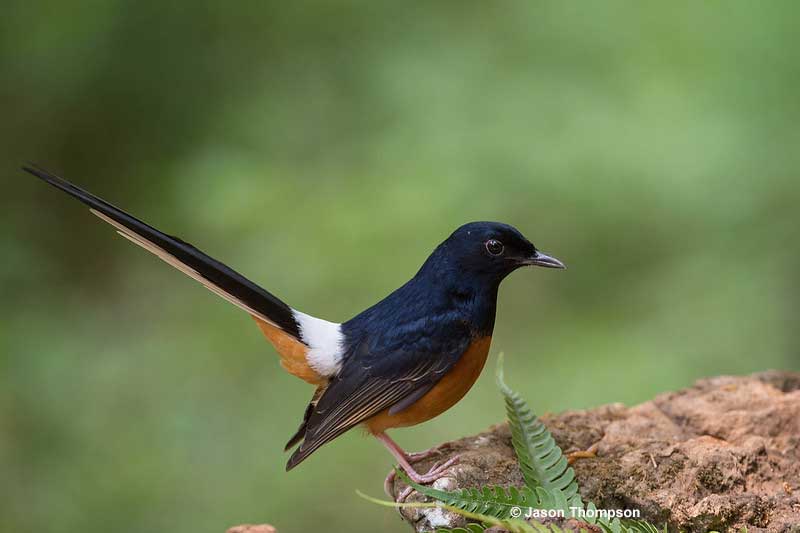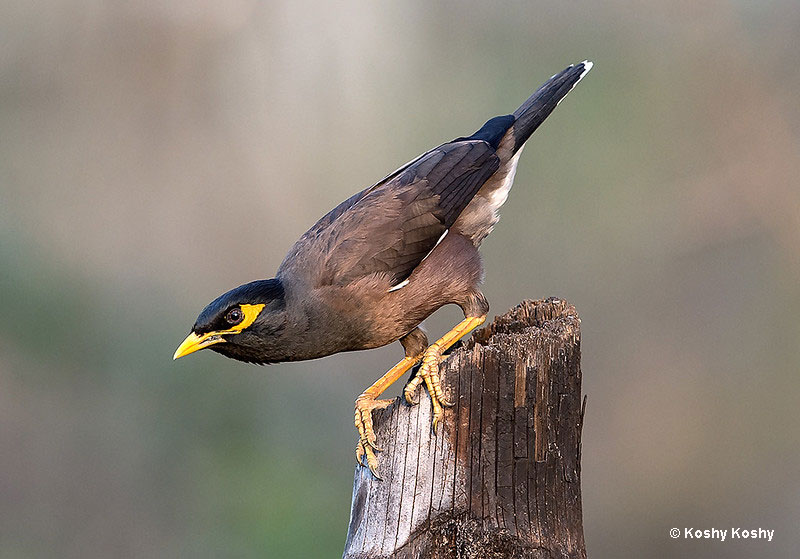
Hawaii, a beautiful archipelago in the Pacific Ocean, is renowned for its unique biodiversity and stunning landscapes. The islands are home to a rich variety of bird species, including many endemic and endangered birds found nowhere else on Earth.
However, Hawaii’s birding situation is challenging due to habitat loss, invasive species, and climate change impacts. Conservation efforts and birding initiatives play a crucial role in protecting and preserving Hawaii’s avian treasures for future generations to appreciate and enjoy.
On this page
- Which Birds Are Common In Hawaii?
- Common Myna
- Zebra Dove
- Warbling White-eye
- Spotted Dove
- House Finch
- House Sparrow
- Cattle Egret
- Northern Cardinal
- Pacific Golden-Plover
- Red-crested Cardinal
- Saffron Finch
- Java Sparrow
- Red Junglefowl
- Common Waxbill
- Red-vented Bulbul
- Apapane
- Black-crowned Night-Heron
- Black-necked Stilt
- Rock Pigeon
- Yellow-fronted Canary
- Yellow-billed Cardinal
- Hawaiian Coot
- Hawaii Amakihi
- Hawaiian Goose
- White-rumped Shama
- Frequently Asked Questions
Which Birds Are Common In Hawaii?
Using eBird sightings, we made the following list of the most commonly seen birds in Hawaii. These birds are arranged from the most common to the least common species but remember that the birds on the bottom of the list are frequently seen too!
We also include information about appearance and behavior to help identify these birds.
Common Myna
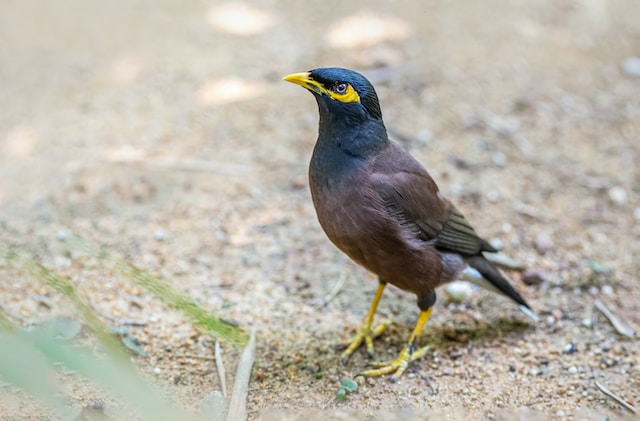
Scientific name: Acridotheres tristis
Length: 9.1 inches
Weight: 3.8 ounces
Wingspan: 18 inches
The Common Myna is a medium-sized songbird native to South Asia that has been introduced to Hawaii.
It has a glossy black plumage, a yellow beak, and vibrant yellow eye patches. These mynas are known for their vocalizations and adaptability to urban and agricultural landscapes. They have a diverse diet that includes fruits, insects, and even small vertebrates.
The Common Myna’s distinctive appearance and lively nature make it a common sight and sound in Hawaii’s bird community.
Zebra Dove
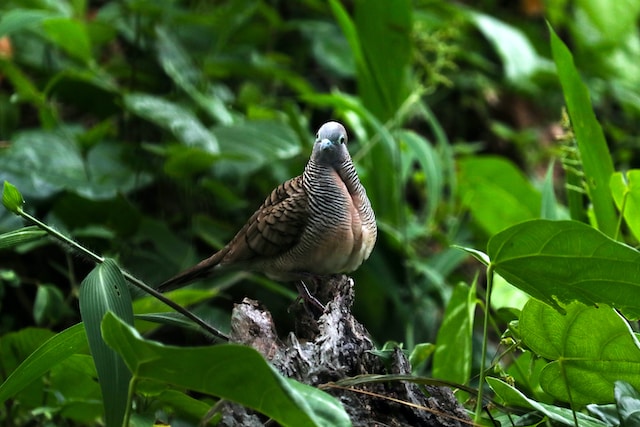
Scientific name: Geopelia striata
Length: 8.6 inches
Weight: 2.1 ounces
Wingspan: 9.8 inches
The Zebra Dove, also known as the Barred Ground Dove, is a small dove species native to Southeast Asia that has become naturalized in Hawaii.
It has a delicate and charming appearance, with soft, brownish-gray plumage adorned with black and white stripes on its neck and wings. These doves inhabit a range of habitats, including forests, gardens, and urban areas. They primarily feed on seeds and grains, often foraging on the ground.
The Zebra Dove’s gentle cooing and elegant presence make it a beloved and familiar sight in Hawaii’s avian landscape.
Warbling White-eye
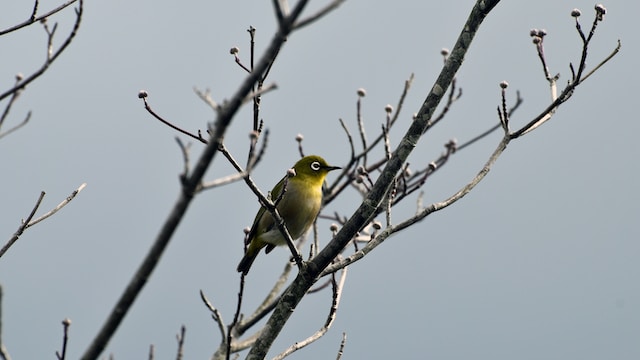
Scientific name: Zosterops japonicus
Length: 4.5 inches
Weight: 0.3 ounces
Wingspan: 3 inches
The Warbling White-eye is a small passerine bird native to East Asia that was introduced to Hawaii in 1929. It has olive-green plumage, a distinctive white eye ring, and a melodious warbling call. As expected, these highly sociable white-eyes often form flocks, particularly in forested areas and gardens. They have a diverse diet that includes nectar, fruits, insects, and small invertebrates.
The Warbling White-eye’s charming appearance and melodious songs make it a sought-after species among birdwatchers in Hawaii.
Spotted Dove
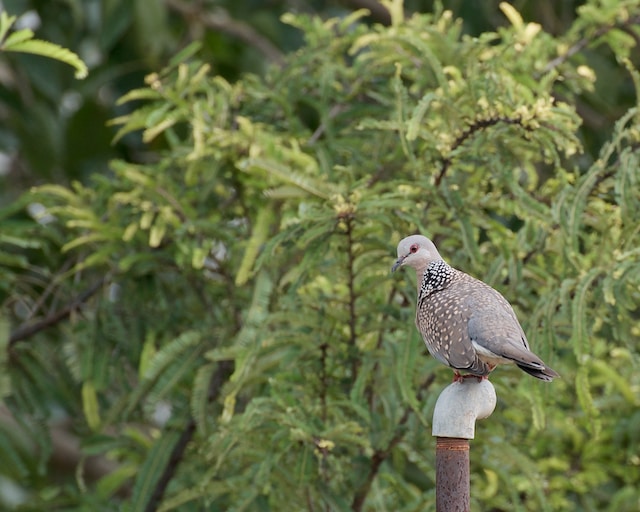
Scientific name: Streptopelia chinensis
Length: 12 inches
Weight: 5.6 ounces
Wingspan: 17 inches
The Spotted Dove is a medium-sized dove species native to Southeast Asia that has been introduced to Hawaii. It has a soft, pinkish-gray plumage adorned with black spots on its wings and back.
These doves are often seen perched on trees and rooftops, adding a touch of serenity to Hawaii’s landscapes. They have a gentle cooing call and primarily feed on seeds and grains. The Spotted Dove’s elegant appearance and calm demeanor make it a peaceful presence in Hawaii’s avian community.
House Finch
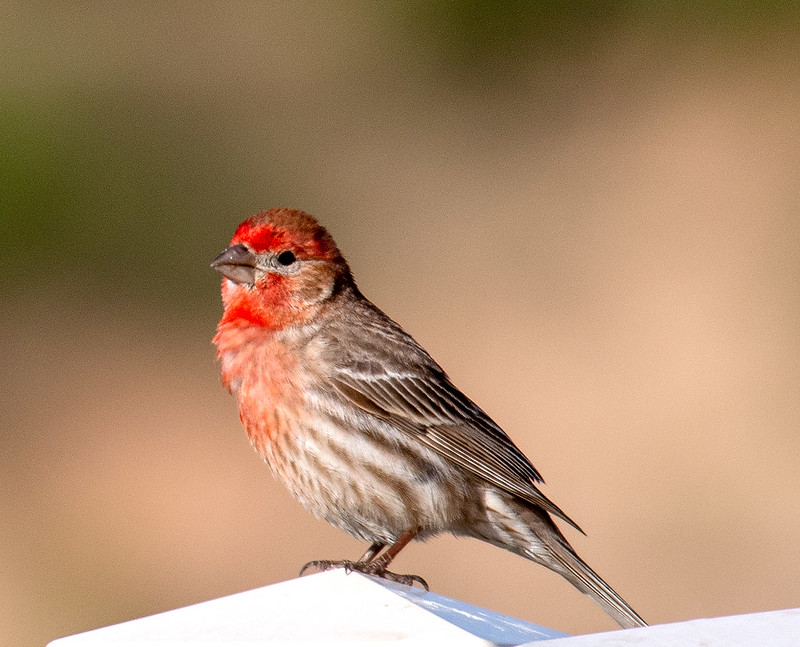
Photograph © John Hansen
Scientific name: Haemorhous mexicanus
Length: 6 inches
Weight: 0.88 ounces
Wingspan: 10 inches
House Finches are sparrow-sized birds with dark, rounded beaks and fairly long wings. Males are orange-red or rose-red on their head, throat and breast, and have some red on their rump. They also have brownish streaks on their back, flanks, and white belly.
Like the male, female House Finches have two white wing bars on long, gray-brown wings. However, they lack red and are mostly streaked, dull brown-gray birds.
House Finches feed on seeds, buds, fruit, and flowers. They often visit feeders in Hawaii but also forage on the ground, and in bushes and trees.
We see these pretty birds in deserts and arid zones, and in parks, farmland, urban areas, and other semi-open habitats.
Although they are usually associated with the mainland, they have a stable population on the Hawaiian islands.
House Sparrow
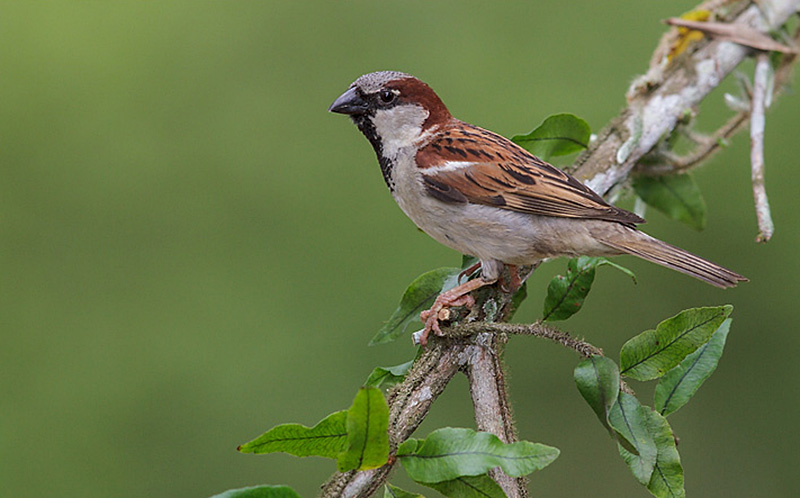
Scientific name: Passer domesticus
Length: 6.25 inches
Weight: 0.98 ounces
Wingspan: 9.5 inches
House Sparrows are small, plump gray and brown birds with conical, finch-like beaks. Males have a gray and rufous head with pale cheeks and black near their eyes and on their throat.
The rest of their underparts are gray and they have brown, streaked backs with rufous highlights. They also have a white mark on the shoulder of each wing and a grayish rump and tail.
House Sparrows feed on seeds, grain, and insects. They also forage on the ground in farmlands, parks, urban areas, and other open situations.
Just like in other states, House Sparrows have a large population, making them one of the most common birds of Hawaii.
Cattle Egret
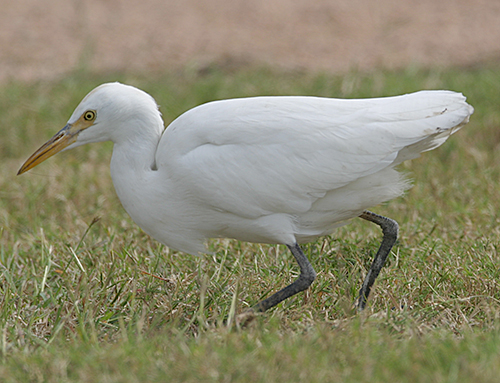
Photograph © Sam Crowe.
Scientific name: Bubulcus ibis
Length: 20 inches
Weight: 18 ounces
Wingspan: 35 inches
The Cattle Egret is a striking and adaptable bird species that has made its mark in the diverse ecosystems of Hawaii. Originally native to Africa, this medium-sized egret has successfully colonized various regions of the world, including the Hawaiian Islands.
Cattle Egrets are known for their bright white plumage, short yellow beak, and distinctive orange-buff feathers on their heads and chests during breeding season.
They can often be spotted foraging in fields and pastures, where they follow grazing livestock, such as cattle and horses, to feed on insects flushed out by their movement. This unique feeding behavior has earned them the nickname “Cattle Egret.”
These birds are highly social and often gather in large flocks, creating an impressive spectacle when in flight or roosting in trees. Their adaptability to diverse environments, from grasslands to wetlands, has enabled them to thrive in Hawaii’s varied landscapes.
The Cattle Egret’s presence in Hawaii adds to the fascinating array of bird species found in the archipelago, captivating birdwatchers and nature enthusiasts with their graceful flight and cooperative behaviors.
Northern Cardinal
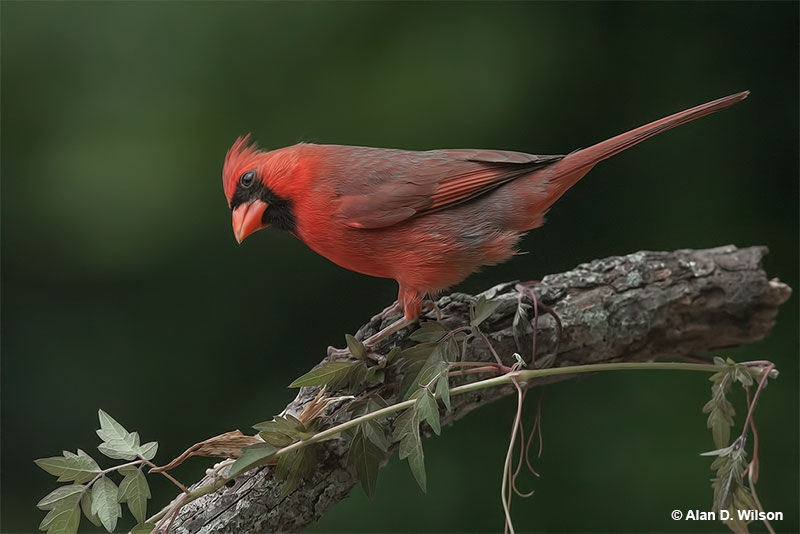
Scientific name: Cardinalis cardinalis
Length: 8.75 inches
Weight: 1.6 ounces
Wingspan: 12 inches
Northern Cardinals are medium-sized songbirds with a perky crest and big orange-red beak. Males are bright red with a black throat and face, and have dusky red on their back, wings, and tail.
Female Northern Cardinals are grayish-brown and buff with some black on their face and throat. They also have red highlights in their crest, wings, and long, rounded tail.
This species has short, rounded wings and seems to bounce up and down as they move through the air. In flight, Northern Cardinals also make sharp chip notes.
The Northern Cardinal is a bird of second growth, gardens, and parks. It eats seeds, insects, and some fruit and is a regular visitor to bird feeders. They forage on and near the ground but males sing from a prominent perch.
This beautiful bird occurs in pairs and nests in bushes and low trees. Similarly to other states, Northern Cardinals are one of the most common birds of Hawaii.
Pacific Golden-Plover
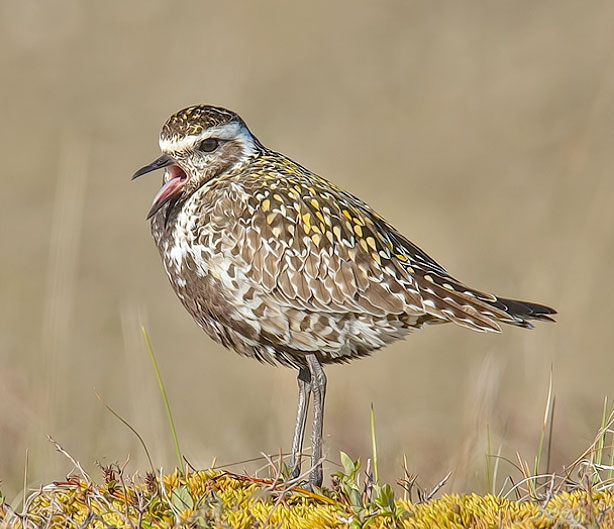
Photograph © Alan Wilson
Scientific name: Pluvialis fulva
Length: 10 inches
Weight: 3.8 ounces
Wingspan: 24 inches
The Pacific Golden-Plover is a migratory shorebird known for its stunning plumage and long-distance flights. During the breeding season, it displays a striking black and gold coloration, with a black face and underparts, while the rest of its body is adorned in golden tones.
These plovers have a slender build and long legs, allowing them to forage for insects and small crustaceans along coastal areas. They undertake remarkable migrations, traveling thousands of miles between their Arctic breeding grounds and their wintering habitats in Hawaii and other Pacific islands.
Red-crested Cardinal
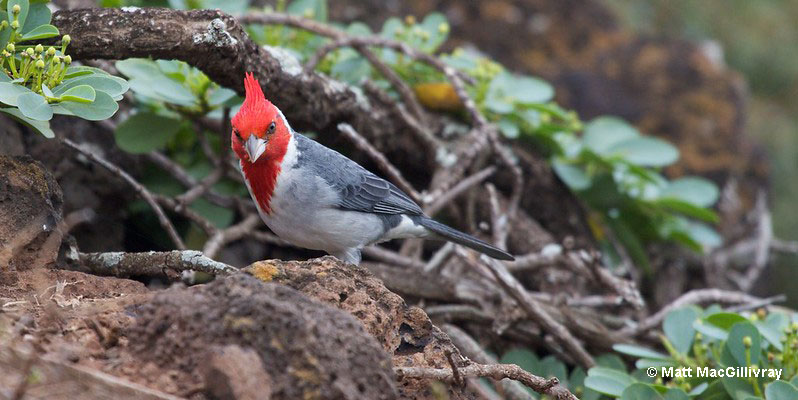
Scientific name: Paroaria coronata
Length: 7.5 inches
Weight: 1.1 ounces
Wingspan: 7.6 inches
The Red-crested Cardinal is a vibrant bird native to South America that has established itself in Hawaii. It features a bold red crest on its head, contrasting with its black face and body.
The rest of its plumage is predominantly gray, with white accents on the wings and tail. These cardinals are highly territorial and known for their melodious songs.
Red-crested Cardinals inhabit various habitats, including forests, gardens, and parks, where they feed on seeds, fruits, and insects. Their striking appearance and lively presence make them a popular sight among birdwatchers.
Saffron Finch
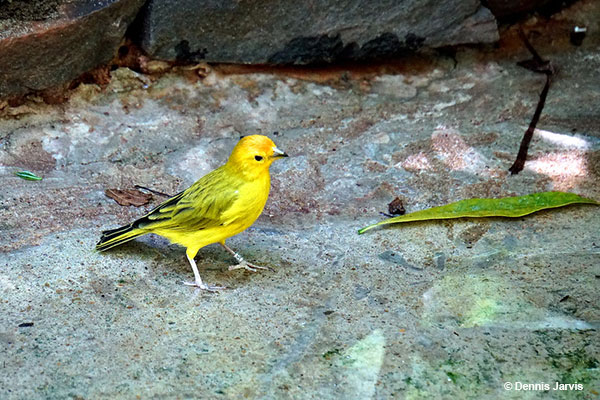
Scientific name: Sicalis flaveola
Length: 5.2 inches
Weight: 0.7 ounces
Wingspan: 7 inches
The Saffron Finch is a small passerine bird native to South America that has become naturalized in Hawaii. It boasts a vibrant yellow plumage with black wings and tail, and a small black beak.
The male sports a bold black bib on its chest, while females exhibit a more subdued coloration. These finches are often found in open grasslands, gardens, and agricultural areas, where they feed on a varied diet of seeds, nectar, and insects.
Their cheerful chirping and bright appearance make them a delightful addition to Hawaii’s avian diversity.
Java Sparrow
Scientific name: Lonchura oryzivora
Length: 6 inches
Weight: 0.86 ounces
Wingspan: –
The Java Sparrow, also known as the Java Rice Bird or Java Finch, is a small passerine native to Indonesia but introduced to Hawaii.
It features a plump body with a grayish-brown coloration, complemented by a striking white patch on its cheeks and a black head. The male displays a pinkish hue on its chest and beak, while the female exhibits a more subdued appearance.
These sociable sparrows are often found in grasslands, farmlands, and urban areas. They primarily feed on seeds and grains but also consume insects and nectar. Their charming presence and unique appearance make them a favorite among bird enthusiasts.
Red Junglefowl
Scientific name: Gallus gallus
Length: up to 2.3 feet
Weight: 1.7 lbs
Wingspan: 35 inches
The Red Junglefowl is a colorful member of the pheasant family and is considered the wild ancestor of domesticated chickens. It features a vibrant combination of glossy red, green, and bronze plumage.
The male is known for its long, flowing hackles and a distinctive red comb on its head, while the female displays a more camouflaged brown coloration.
Red Junglefowls are primarily ground-dwelling birds, residing in forests, grasslands, and scrublands. Their diet consists of seeds, fruits, insects, and small animals. These birds have an important cultural significance, and their vocal calls and distinctive appearance add to the charm of Hawaii’s avian landscape.
Common Waxbill
Scientific name: Estrilda astrild
Length: 4.7 inches
Weight: 0.3 ounces
Wingspan: 5.1 inches
The Common Waxbill, also known as the St. Helena Waxbill, is a small passerine bird originally from sub-Saharan Africa that has been introduced to Hawaii. It showcases a striking combination of red, black, and gray plumage, with a slender beak and a black mask.
Red-vented Bulbul
Scientific name: Pycnonotus cafer
Length: 7.8 inches
Weight: 1.2 oz
Wingspan: –
The Red-vented Bulbul is a small songbird native to Southeast Asia that has been introduced to Hawaii. It has a sleek, compact body with brownish-gray plumage, a pointed crest on its head, and a distinctive red patch on its vent.
The Bulbul’s melodious calls and lively nature make it a popular resident in gardens, parks, and urban areas. It feeds on a varied diet of fruits, nectar, insects, and small vertebrates.
Apapane
Scientific name: Himatione sanguinea
Length: 5 inches
Weight: 0.45 ounces
Wingspan: 5.5 inches
The Apapane is a species of honeycreeper endemic to Hawaii. It showcases vibrant red plumage, with black wings and a slightly curved bill. Males and females have a similar appearance.
These birds inhabit montane and subalpine forests, where they forage on nectar, insects, and occasionally fruits.
Apapane’s distinctive calls and aerial acrobatics, often observed hovering near flowers, contribute to its allure and make it a sought-after species among birdwatchers.
Black-crowned Night-Heron
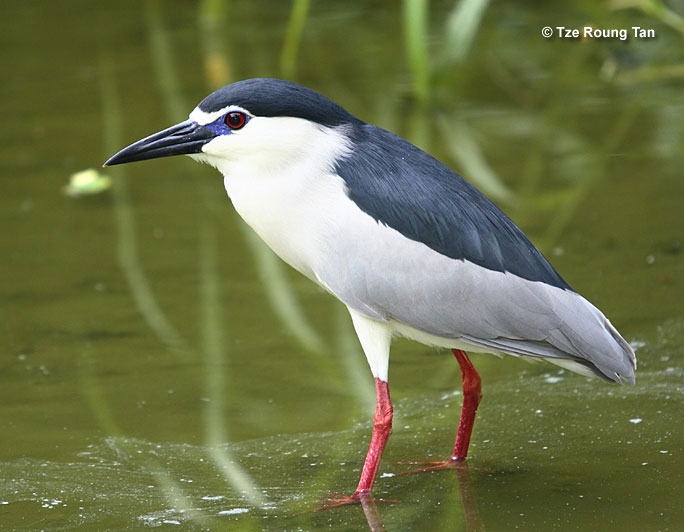
Scientific name: Nycticorax nycticorax
Length: 26 inches
Weight: 2.2 lbs
Wingspan: 46 inches
The Black-crowned Night Heron is a medium-sized heron found in various regions worldwide, including Hawaii. It has a stocky build, grayish-black plumage, and distinctive red eyes.
These herons are most active during the night, feeding on a diet primarily composed of fish, amphibians, crustaceans, and insects.
They can be spotted near wetlands, marshes, and coastal areas, often perched motionless on tree branches or wading in shallow waters. The Black-crowned Night-Heron’s nocturnal habits and unique appearance make it an intriguing addition to Hawaii’s avifauna.
Black-necked Stilt
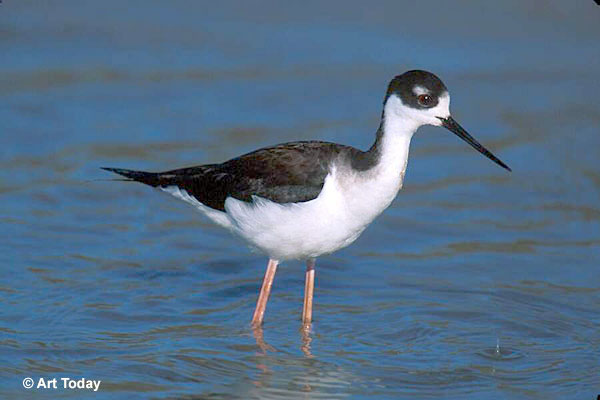
Scientific name: Himantopus mexicanus
Length: 15 inches
Weight: 6 ounces
Wingspan: 30 inches
The Black-necked Stilt is a graceful wading bird known for its long, thin legs and striking black and white plumage. It has a slender build, a long black neck, and a thin black bill. The head, breast, and back are black, while the belly, wings, and tail are white.
These stilts inhabit a variety of wetland habitats, including marshes, mudflats, and estuaries, where they feed on small invertebrates and insects.
Their distinctive appearance and elegant foraging behavior, often seen wading in shallow waters on their long legs, make them a captivating sight for birdwatchers and nature enthusiasts.
Rock Pigeon
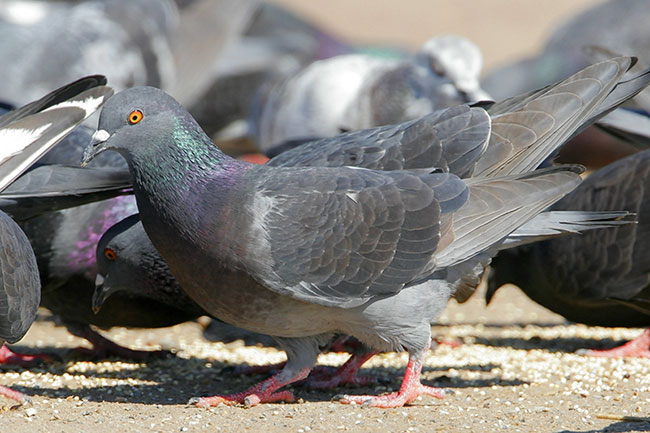
Scientific name: Columba livia
Length: 12.5 inches
Weight: 9 ounces
Wingspan: 28 inches
The Rock Pigeon is the familiar and common “pigeon” of cities, farms, and other urban situations. Although this pigeon can show a variety of plumages, the most frequent one is pale gray with dark gray on the head and neck, and a dark gray tail with a dark tip.
Rock Pigeons usually occur in flocks and large ones can form in farm fields and some urban areas. They pick seeds and grain from the ground, mostly in open areas like farm fields, parks, and city streets.
Rock Pigeons are completely adapted to living with people and occur in urban and farming areas in most parts of North America. They are some of the most common birds in Hawaii.
Yellow-fronted Canary
Scientific name: Crithagra mozambica
Length: 4.7 inches
Weight: 0.6 ounces
Wingspan: 8.6 inches
The Yellow-fronted Canary is a small songbird native to Africa that has been introduced to Hawaii. It features a vibrant yellow plumage on its face, breast, and belly, contrasting with brownish-gray wings and back.
These canaries are often found in grasslands, open areas, and gardens, where they feed on seeds and occasionally insects. Their cheerful song and bright coloration make them a delightful addition to Hawaii’s bird population.
Yellow-billed Cardinal
Scientific name: Paroaria capitata
Length: 6.6 inches
Weight: 0.7 ounces
Wingspan: –
The Yellow-billed Cardinal is a colorful bird native to South America that has established itself in Hawaii. It exhibits a striking combination of bright red plumage, a black face mask, and a distinctive yellow beak.
These cardinals are known for their melodic songs and can be found in various habitats, including forests, shrublands, and urban areas. They primarily feed on seeds, fruits, and insects. The Yellow-billed Cardinal’s vivid appearance and musical talent make it a sought-after sight among bird enthusiasts.
Hawaiian Coot
Scientific name: Fulica alai
Length: 14 inches
Weight: 1.5 lbs
Wingspan: 25 inches
The Hawaiian Coot is an endemic waterbird found exclusively in the Hawaiian Islands. It has a compact body, slate-gray plumage, and a distinctive white frontal shield on its forehead.
These coots inhabit freshwater wetlands, ponds, and marshes, where they forage on aquatic vegetation, insects, and small invertebrates. They are excellent swimmers and divers, using their lobed feet for propulsion in the water.
The Hawaiian Coot’s localized distribution and unique adaptations contribute to its significance as a symbol of Hawaiian biodiversity.
Hawaii Amakihi
Scientific name: Chlorodrepanis virens
Length: 5 inches
Weight: 0.45 ounces
Wingspan: 7 inches
The Hawaii Amakihi is a small forest bird endemic to Hawaii. It exhibits a bright green plumage, with yellow undertail coverts and a slender, curved beak.
These amakihi primarily inhabit native forests, where they forage on nectar, insects, and small fruits. They are known for their acrobatic feeding behaviors, often hanging upside down while probing flowers for nectar.
The Hawaii Amakihi’s vibrant coloration and agile movements make it a captivating representative of Hawaii’s unique avian fauna.
Hawaiian Goose
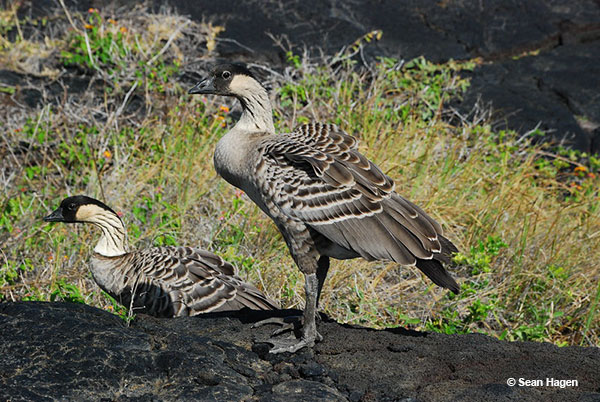
Scientific name: Branta sandvicensis
Length: 23 inches
Weight: 2.4 lbs
Wingspan: 37 inches
The Hawaiian Goose, also known as the Nene, is the state bird of Hawaii and an iconic symbol of the islands. It is a medium-sized goose with a distinctive coloration, featuring a dark brown body, a black face, and striking white cheek patches.
The Hawaiian Goose is an endemic species and one of the rarest geese in the world. It is primarily found in grasslands, shrublands, and lava fields, where it feeds on grasses, herbs, and leaves. Conservation efforts have been instrumental in protecting this endangered species and ensuring its survival.
White-rumped Shama
Scientific name: Copsychus malabaricus
Length: 10 inches
Weight: 1 ounces
Wingspan: 11.5 inches
The White-rumped Shama is a songbird native to Southeast Asia that has been introduced to Hawaii. It has a black body with a contrasting white rump, and the male displays a striking long, black tail.
These shamas are known for their melodious and varied songs, making them popular cage birds. In Hawaii, they can be found in forests, gardens, and urban areas, where they feed on insects, fruits, and nectar.
The White-rumped Shama’s beautiful plumage and enchanting vocalizations add to the avian diversity and auditory landscape of Hawaii.
Frequently Asked Questions
How many bird species does Hawaii have?
At the moment, there are 337 bird species living in Hawaii, many of them introduced.
Does Hawaii have birds of prey?
Even though far from the mainland, Hawaii does have some birds of prey. The most notable examples are Hawaiian Hawks, Northern Harriers, Ospreys, Peregrine Falcons, and even Barn Owls and Short-eared Owls.
How many endangered birds does Hawaii have?
Out of the endemic birds in Hawaii, six are endangered, and 11 are critically endangered.
How many Hawaiian bird species have gone extinct?
When it comes to endemic birds, there are 30 known species that have gone extinct over the years.
Do albatrosses live in Hawaii?
Albatrosses live in the Pacific Ocean and use islands for breeding. If you’re lucky, you can see Laysan Albatrosses or Black-footed Albatrosses around the islands.


